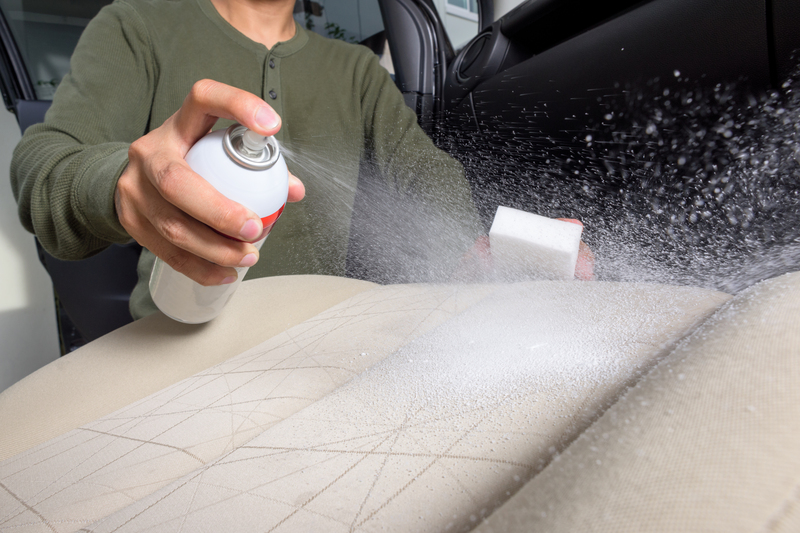Discover the Secrets to Mould-Free Window Sills
Posted on 27/06/2025
Discover the Secrets to Mould-Free Window Sills
Are you tired of battling unattractive black spots and musty odours around your window frames? If so, you're not alone. Mould growth on window sills is a common household problem, but it isn't just an unsightly nuisance - it can also pose health risks and cause significant damage to your home.
In this comprehensive guide, we'll unveil the secrets to achieving and maintaining mould-free window sills. You'll discover actionable tips, preventive strategies, and expert advice that will help you enjoy brighter, healthier, and cleaner living spaces.

Understanding Mould on Window Sills
Before you can truly keep your window ledges mould-free, it's crucial to understand what causes it. Mould thrives in damp, poorly ventilated environments. Window sills are especially vulnerable because:
- Condensation often forms on window panes, dripping down onto the sill.
- Cracks or gaps in the frame allow moisture to seep in.
- A lack of airflow enables humidity to accumulate.
- Organic debris, such as dust or pollen, provides food for mould spores.
If left unchecked, mould on window ledges can damage paint, rot wooden frames, and ruin silicone seals. The spores also decrease indoor air quality and may trigger allergies or respiratory issues.
Why Is It Important to Prevent Mould on Window Sills?
Addressing the problem early is vital because:
- Protects your home's structural integrity
- Preserves indoor air quality
- Reduces health risks for family and pets
- Minimises cleaning and repair costs
- Prevents more severe infestations
The Secrets to Mould-Free Window Sills
1. Improve Ventilation
The number one secret to keeping window sills free from mould is boosting ventilation. Air movement is essential for reducing condensation and excess humidity. Here's how to ensure better airflow:
- Open windows regularly to let out moist air, especially after cooking or showering.
- Install trickle vents which allow continuous background ventilation without compromising security.
- Use extractor fans in kitchens and bathrooms to expel steam.
- Consider a dehumidifier if you live in a particularly humid climate or your windows often mist up.
2. Tackle Condensation at Its Source
Condensation is the leading cause of window ledge mould. Here's how to keep it in check:
- Wipe up moisture on window panes and sills every morning, especially during winter.
- Avoid drying clothes on radiators and near windows--excess steam can settle on cold surfaces.
- Maintain your home's relative humidity below 60%.
- Keep furniture at least a few inches away from windows to promote air circulation.
3. Regular Cleaning and Maintenance
An often overlooked secret to mould-free window sills is consistent cleaning. Dust and debris trap moisture, providing an ideal spot for spores to settle.
- Vacuum or dust your window sills weekly to remove loose particles.
- Wash sills with a mixture of warm water and mild detergent.
- For stubborn stains, use a solution of white vinegar or bicarbonate of soda - both are effective natural mould removers.
- After cleaning, dry thoroughly with a clean cloth.
4. Seal Gaps and Repair Damage
Cracks and leaks are a major cause of mouldy window sills. Water can seep in through worn-out seals, chipped paint, or damaged caulking, especially after heavy rain.
- Inspect windows regularly for gaps or deteriorated weatherstripping.
- Reapply a high-quality, waterproof sealant where needed. This prevents moisture from penetrating the frame.
- If you spot blistering paint or spongy wood, consider repairing or replacing the affected area to stop further rot.
5. Upgrade to Double or Triple Glazing
Single-pane windows are prone to condensation buildup. Upgrading to double or triple-glazed windows provides these benefits:
- Minimises temperature differences, thus reducing condensation.
- Improves energy efficiency and keeps rooms warmer.
- Less cold surface for moisture to settle - keeping your sills drier.
6. Use Mould-Resistant Paint or Treatments
Specialist anti-mould paints and sprays are available that contain fungicidal compounds. Applying these to your window sills and surrounding walls offers:
- Ongoing protection against spore regrowth
- An invisible, long-lasting barrier
- Extra peace of mind in problem areas
Always clean and completely dry the surface before applying any anti-mould paints for best results.
How to Remove Existing Mould from Window Sills
If you've already spotted fuzzy spots or black streaks, don't panic! Here's a step-by-step guide to safely remove mould from your window sills and restore them to their original state.
- Gear up: Wear gloves and a mask to avoid inhaling spores or getting them on your skin.
- Mix your cleaning solution: Combine equal parts white vinegar and water, or use a commercial mould remover.
- Apply the solution: Spray generously onto the affected area and allow it to sit for 10-15 minutes.
- Scrub the surface: Use a soft brush or sponge to remove the mould. Avoid using abrasive scrubbers as they can damage the sill.
- Rinse and dry: Wipe off with a clean, damp cloth, then thoroughly dry the area with a towel.
- Dispose of cleaning materials: Place used towels and sponges in a sealed bag and throw them away to avoid spreading spores.
- Repeat if necessary: For severe infestations, you may need to repeat this process or call in a professional cleaner.
Caution: Never mix bleach with ammonia-based cleaners--it creates hazardous fumes. Use cleaning agents separately and only in well-ventilated spaces.
Long-Term Strategies for Maintaining Mould-Free Window Ledges
Monitor Indoor Humidity
A key element of keeping window sills free of mould is managing humidity inside your home. Invest in a simple hydrometer to keep an eye on levels, and take steps to reduce moisture if the percentage creeps above 60%:
- Run a dehumidifier in chronically damp rooms
- Use lids on saucepans to limit steam
- Vent tumble dryers outside
- Clean extractor fan filters regularly to improve their performance
Keep Curtains and Blinds Open When Possible
Heavy or thick window dressings can trap moisture against the glass and sill, creating a sheltered environment for mould to flourish. To help keep window ledges mould-free:
- Open blinds and curtains during the day to let sunlight and air circulate
- Avoid leaving wet or damp fabrics near your windows
Address Leaks Promptly
Water leaking in from outside is a chief culprit for recurring window sill mould. After storms or heavy rain, check your windows:
- Inspect caulking and frames for water trails or swelling
- Repair cracked glass or frames immediately
- Ensure guttering and downpipes direct water away from your property's walls
Minimise Indoor Plants Around Window Sills
Plants need water, and excess watering can spill onto window ledges, increasing humidity. For easier maintenance and mould prevention on window sills:
- Use saucers under plant pots to catch drips
- Avoid overwatering
- Wipe up spills immediately

FAQs: Secrets to Mould-Free Window Sills
Why does mould keep coming back after I clean it?
If you're repeatedly cleaning your window sills but the mould returns, you may not be addressing the root cause. Treating the symptoms is only part of the solution. For lasting success, combine removal with ventilation, humidity control, and sealing gaps.
Is mould on window sills dangerous?
Mould can have health implications, especially for those with asthma, allergies, or weakened immune systems. It may result in coughing, sneezing, or respiratory problems. Keeping your window ledges mould-free is essential for a healthy home environment.
Does painting over mould stop it?
Absolutely not. Painting over mould might hide it, but it won't eradicate the spores. Always clean and treat the area first, then apply an anti-mould paint for best results.
Are there natural remedies for mould prevention?
Yes! Vinegar, tea tree oil, and baking soda are all effective for cleaning small areas and preventing minor mould growth. However, persistent or widespread mould may require commercial cleaners or professional intervention.
Conclusion: A Mould-Free Window Sill is Within Your Reach!
- Improved ventilation, routine cleaning, and preventing condensation are the foundation for defeating unwanted mould.
- Maintain your sills, seal gaps, and choose mould-resistant materials.
- Act quickly when you spot signs of moisture or decay, and you'll enjoy healthier, brighter, mould-free window sills for years to come.
By following these secrets to mould-free window sills, you can safeguard your home, boost your indoor air quality, and say goodbye to stubborn black spots forever. Take control of your living space today and discover the difference!




